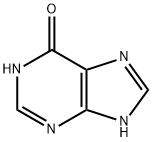All AbMole products are for research use only, cannot be used for human consumption.

Hypoxanthine (6-Hydroxypurine) is a potential free radical generator and could be used as an indicator of hypoxia. 6-Hydroxypurine seems to play a role in posthypoxic reoxygenation cell injury through oxygen radical production and is therefore involved in the pathogenesis of a number of diseases. 6-Hydroxypurine also modulates a number of other processes because it reacts with benzodiazepine receptors and inhibits phosphodiesterase in the brain.
| Molecular Weight | 136.11 |
| Formula | C5H4N4O |
| CAS Number | 68-94-0 |
| Solubility (25°C) | DMSO 8 mg/mL 1 M NaOH: 25 mg/mL |
| Storage |
Powder -20°C 3 years ; 4°C 2 years In solvent -80°C 6 months ; -20°C 1 month |
[2] Yasuhiro Oba, et al. Nat Commun. Nucleobase synthesis in interstellar ices
| Related Metabolite/Endogenous Metabolite Products |
|---|
| Quercetin 7-glucuronide
Quercetin 7-glucuronide can inhibit LDL oxidation. Quercetin 7-glucuronide (Quercetin 7-O-β-glucuronide) can be isolated from Madagascarian Uncarina species. |
| D-Tryptophan
D-Tryptophan is the D-isomer of tryptophan, as a non-protein active amino acid, has special physiological properties, can be used as additives, plant growth agents, etc. In the pharmaceutical industry, it is mainly used in the synthesis of various polypeptides, instead of L-tryptophan to extend the peptide half-life. |
| Arachidonic acid sodium salt
Arachidonic acid sodium salt (Sodium Arachidonate) is a polyunsaturated omega-6 fatty acid and a major constituent of biomembranes. Arachidonic acid sodium salt also acts as the substrate for various lipid mediators, such as prostaglandins (PGs). |
| trans-Vaccenic acid
trans-Vaccenic acid is a naturally occurring trans fatty acid (TFA). trans-Vaccenic acid is a precursor for the synthesis of saturated fatty acid in the rumen and of conjugated Linoleic acid (CLA) at the tissue level. trans-Vaccenic acid inhibits nasopharyngeal carcinoma (NPC) cell growth and induces apoptosis through the inhibition of Bad/Akt phosphorylation. |
| Mead acid
Mead acid (5,8,11-Eicosatrienoic acid) is an unsaturated (Omega-9) fatty acid. |
All AbMole products are for research use only, cannot be used for human consumption or veterinary use. We do not provide products or services to individuals. Please comply with the intended use and do not use AbMole products for any other purpose.


Products are for research use only. Not for human use. We do not sell to patients.
© Copyright 2010-2024 AbMole BioScience. All Rights Reserved.
